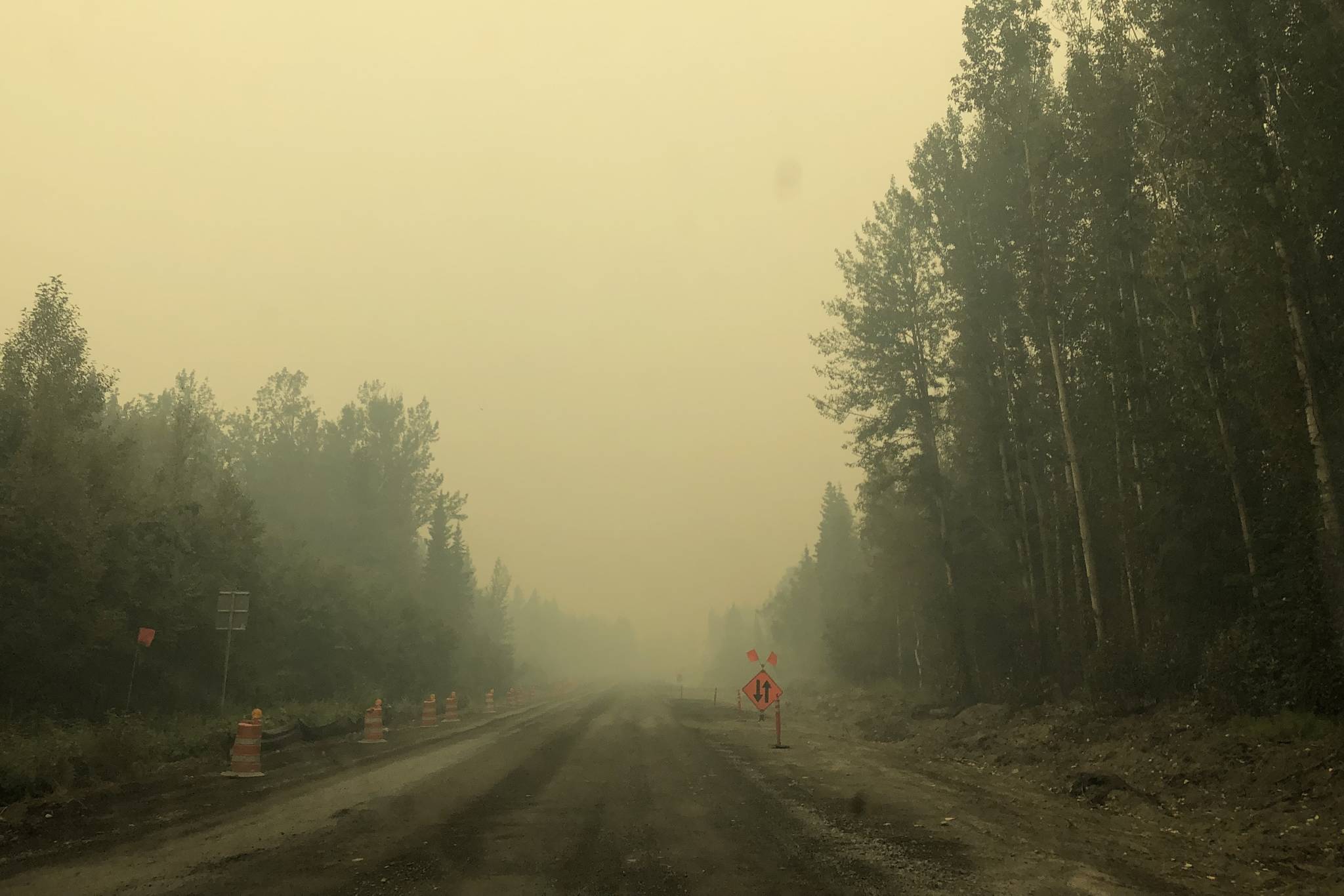Fire crews battling the Swan Lake Fire prioritized protecting the Sterling Highway Tuesday in an attempt to keep the roadway open to traffic.
The highway was closed on Sunday night after the Swan Lake Fire exhibited intense growth and crossed the road in several places. By noon on Monday the highway was reopened, but within a few hours the fire began backing toward the highway from the south, prompting another closure at 6:30 p.m. that lasted through the night. At 10 a.m. on Tuesday the highway was opened again to one-lane traffic and pilot car operations. By that time, however, the closures had already impacted hundreds of travelers.
As of mid-afternoon Tuesday, traffic was flowing steadily through Cooper Landing, Nikiski resident Byron Grenier said. Grenier tried to make it through Cooper Landing on Sunday, but was prevented by the road closure. He tried again Monday, but had to turn back after traffic stopped in the evening.
“I got there around 6:20. The road closed at 6:15 so I ended up turning back,” Grenier said.
Grenier was able to make it through Tuesday afternoon. He said he didn’t spot any flames immediately along the highway, but described seeing scorched hillsides and “big, healthy birch trees” that had been toppled by the fire.
Katherine O’Leary-Cole is the head chef at Kingfisher Roadhouse, and she described the scene as Alaskans and tourists alike took refuge at the Cooper Landing restaurant during the highway closures.
“There’s a lot of tourists coming in that are still just completely confused,” O’Leary-Cole said. “And all the locals like the guides and hotel owners — all their trips were canceled so they don’t really have anything to do except come here.”
O’Leary Cole, who moved to Alaska at the start of the summer, spent most of her life in southern states like Arkansas and South Carolina, so wildfires of this magnitude are a new experience for her.
“It kinda reminds me of the East Coast when a hurricane would come through … but with a hurricane you know roughly when it’s going to hit and at what level, and here it’s just like, ‘I don’t know what’s going on’,” O’Leary-Cole said.
Since the Swan Lake Fire started on June 5, Cooper Landing has been dealing with moderate to unhealthy smoke conditions. With the recent flare-ups, air quality conditions have transitioned to “hazardous,” leading to the delay of the first day of school for Cooper Landing.
“When we came down in the kitchen (this morning), it was like someone had burnt something on the stovetop because it was so smoky in here,” O’Leary-Cole said. “We’ve all been wearing our bandanas as masks but I don’t know how much that helps.”
Management of the fire is transitioning to the Type 1 Great Basin incident management team. Type 1 teams handle the most complex fire situations.
Brentwood Reid, incident commander for the Type 3 management team, said that as the Type 1 team takes control of the fire, the containment strategy will involve creating new control lines in the areas that experienced growth over the weekend. On the western perimeter, a control line is being established south of the Sterling Highway where the fire burned out to Skilak Lake. On the eastern side of the fire, hotshot crews are looking at establishing control lines north of the highway in the area just south of Fuller Lake and along the southern portion of the Resurrection Pass Trail to prevent further spread toward Cooper Landing.
Reid said that this late into the fire season, establishing these control lines is the most effective strategy for containment because it creates a barrier without fuels that stops the fire in its tracks. Suppression efforts have been hindered by drought conditions on the peninsula, and deep layers of dry duff make water drops relatively ineffective. The latest measurement puts the fire at 138,479 acres, and fire crews have it about 20% contained.
Reid said that fire season in Alaska typically ends with a large high-pressure system that brings rainfall consistent enough to moderate fire behavior. Once such system started in the eastern interior of Alaska near Fairbanks a couple weeks ago and traveled southwest through the peninsula. Fairbanks saw about 4 inches of rain — which was enough to effectively end their fire season. The Kenai Peninsula only got about 2 inches of rain as part of that weather system, which merely slowed the Swan Lake Fire’s growth until a weekend of high and dry winds breathed new life into the blaze.
Reid said that at least 4 inches of continuous rain is needed to end the drought and the fire season on the peninsula. So while the Interior is now receiving snow advisories and Tok experienced temperatures of 20 degrees Fahrenheit Tuesday morning, fire crews on the Kenai Peninsula are holding the line and holding out hope for more rain. Forecasts on the National Weather Service Website show the potential for light showers later this week, but as of now there is no high-pressure system on the horizon that would bring sufficient rainfall.
There will be a community meeting regarding the Swan Lake Fire on Wednesday, Aug. 21 at 6 p.m. at the Cooper Landing School at 19030 Bean Creek Road in Cooper Landing. A community meeting on the fire will also be held on Thursday, Aug. 22 at 6 p.m. at the Sterling Community Center at 35085 Sterling Highway (Mile 83.5) in Sterling. For more information visit the Office of Emergency Management Joint Virtual Information Center at kpboem.blogspot.com.
Victoria Petersen and Erin Thompson contributed to this story.

